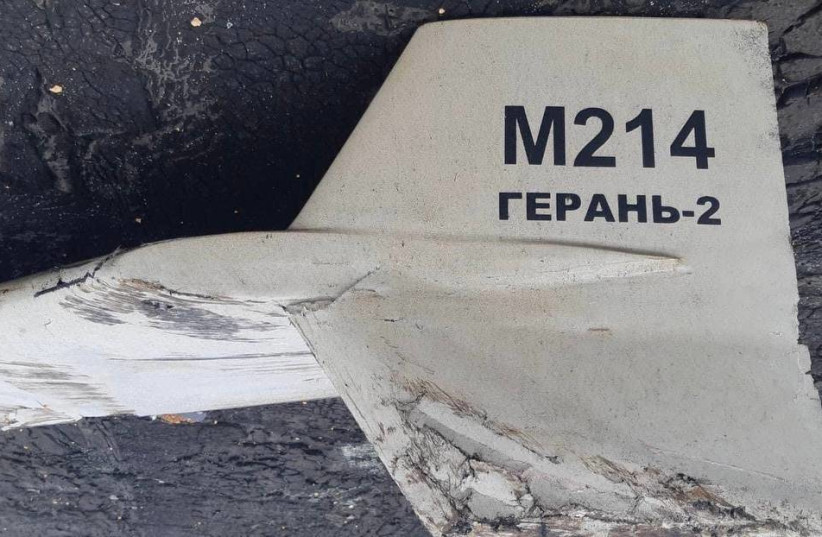Israeli-made infrared lenses, along with over 200 other components from the US, Europe and other allied nations, have been found in Iranian drones used by Russia in its invasion of Ukraine, The Wall Street Journal reported on Wednesday.
About three-quarters of the components of the drones were American-made, according to Ukrainian documents shown to WSJ by the Kyiv-based nonprofit Independent Anti-Corruption Commission (NAKO). Ukrainian investigators made the discovery while examining downed Iranian-made drones, including a Mohajer-6 which was hacked mid-flight and landed intact.
Out of over 200 technical components in the captured Mohajer-6, about half were made by US-based firms and about a third were made by companies in Japan. The servomotors in the drone were made by Japan’s Tonegawa-Seiko Co. according to the report.
The Tonegawa-Seiko Co. was charged last year by Japan's Trade Ministry for exporting servomotors to China without a permit after UN investigators found one in an Iranian drone. The company claimed that it did not know they would be used in military drones.
Parts from the German-owned Infineon Technologies AG and Arizona-based Microchip Technology Inc. were found in the drone as well.

The high-resolution telescopic infrared lens used in the Mohajer-6 appears identical to a model made by the Israeli firm Ophir Optronics Solutions Ltd., according to photos of the device examined by WSJ. MKS Instruments Inc., Ophir’s parent company, told the newspaper that it does not sell parts to Iran and abides by sanctions.
The report stressed that many of the parts found in the drones are not under export controls and can be easily bought online and shipped through other countries to Iran.
Ukrainian intelligence initially suspected that the infrared camera found on the Mohajer-6 was manufactured by the Oregon-based Sierra-Olympic Technologies Inc., which uses Ophir lenses. Chris Johnston, the founder of the company, told WSJ that while part of the device appears the same, other parts are different, suggesting it didn't come from his company.
Johnston added that the parts could have been obtained from Western aircraft downed in Iraq and Afghanistan or from intermediaries who violated US sanctions.
The Israeli Defense Ministry responded to the report on Wednesday evening, stating that Israel is reviewing the findings and that a preliminary review had found that the lens in question is not a controlled defense item nor a dual-use item.
Series of reports warn Western parts found in Iranian drones
The findings are the latest in a string of reports and analyses concerning the presence of Western-made components in Iranian drones.
Earlier this month, Schemes, the investigative unit of RFE/RL's Ukrainian Service, found components on a Mohajer-6 drone originating from at least 15 different technology companies from North America, the EU, Japan and Taiwan, including parts from the US-based Texas Instruments firm. Texas Instruments replied that it does not sell parts to Russia, Belarus, or Iran.
Schemes report pointed out that Iran has a global procurement network built out of front companies and other proxies in third countries. "Exporters will look at the request coming from the [United Arab Emirates] or another third country, and they'll think that they're selling to an end user based there, when really the end user is in Iran," Daniel Salisbury, a senior research fellow with the Department of War Studies at King's College London, told RFE/RL.
In October, CNN and Ukrainian media reported that a Mohajer-6 downed over the Black Sea was found to have engines made by the Canadian Rotax company. After an investigation conducted with a partner in Ukraine, the company announced earlier this month that it had identified the engine and was able to confirm that it was not sold by any of its distributors to Iran or Russia.
Additionally in October, the Institute for Science and International Security analyzed open-source information from downed and captured Iranian drones used by Russia in its ongoing invasion of Ukraine and found parts originating from Austria, Germany, the UK and the US. The Western-made parts were key components in the Shahed-136, Shahed-131, and Mohajer-6 drones.
"A priority is to understand how foreign parts are ending up in Iranian drones," recommended the institute. "Discovering Iranian procurement networks can start with the Western suppliers, who would be expected to cooperate with authorities. From there, authorities need to systematically expose Iran’s procurement network, identifying trading companies, distributors, shipping companies, agents friendly to Iran, and ultimately those in Iran organizing these purchases. In parallel, governments should rip out 'root and branch' these procurement networks as they are discovered."
The institute additionally recommended that the JCPOA nuclear deal not be revived unless Iran stops exporting drones and that the expired UN arms embargo against Iran be reinstated.
In response to the report, Sierra-Olympic released the following statement: Sierra-Olympic Technologies takes its responsibility to be an honorable, lawful, customer-focused company seriously. Since our company was founded nearly 30 years ago, we have prided our ability to maintain a strong and steadfast relationship with the U.S. Department of Commerce while following all of its export controls and regulations. Despite news reports raising questions about the use of one piece of our technology in Iranian drones used by Russia to attack the Ukraine, Sierra-Olympic can unequivocally say it is not possible. These false claims are about a mid-wave infrared camera we designed for long-range security and surveillance operations. Sierra-Olympic only produced four of this particular model. The UK-based company which purchased all four of these cameras has confirmed that they are all accounted for. And while visually the two pieces of technology can seem similar to those not familiar with them, the product in the photos out of Ukraine is not ours. To be clear: we believe any company that circumvents export restrictions, such as those put in place since Russia’s invasion of Ukraine, should absolutely be held responsible. We share this statement not only to clarify the misconceptions about misuse of our technology but to also reiterate our dedication to transparency as a long-trusted brand and company.
